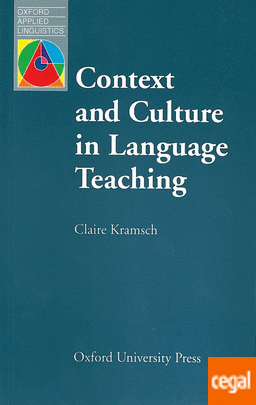EFL/ESL Teaching Strategies
The cultural component of language teaching.
Claire Kramsch (1995)
Despite the advances made by research in the spheres of the intercultural and the multicultural, language teaching is still operating on a relatively narrow conception of both language and culture. Language continues to be taught as a fixed system of formal structures and universal speech functions, a neutral conduit for the transmission of cultural knowledge. Culture is incorporated only to the extent that it reinforces and enriches, not that it puts in question, traditional boundaries of self and other. In practice, teachers teach language and culture, or culture in language, but not language as culture. The theoretical framework I propose here for teaching culture through language suspends the traditional dichotomy between the universal and the particular in language teaching. It embraces the particular, not to be consumed by it, but as a platform for dialogue and as a common struggle to realign differences.
FULL TEXT: https://www.tandfonline.com/doi/abs/10.1080/07908319509525192

Teaching Language in Context, Second Edition, and Teaching Language in Context--Workbook.
Hadley, Alice Omaggio; Reiken, Elizabeth (1993).
The text and accompanying workbook are designed to help second language teachers explore theories of language teaching and learning, deriving a set of hypothesized principles for classroom teaching based on the concept of proficiency and suggesting classroom techniques using them. The first two chapters outline and expand on both theoretical and practical insights into the nature of proficiency. Chapter 3 presents the hypothesized principles. The fourth chapter reviews research on the role of context in comprehension and production of discourse, and the fifth offers suggestions for contextualizing listening and reading practice. Chapters 6 and 7 provide guidelines for contextualizing practice in speaking and writing and for activities integrating all language skills. In chapter 8, the treatment of culture in language teaching is addressed. Chapter 9 presents formats for proficiency-oriented classroom testing, and the final chapter illustrates how daily lesson planning can be proficiency-oriented. Appended materials include American Council on the Teaching of Foreign Languages (ACTFL) proficiency guidelines, samples of error coding procedures for written work, and forms useful for course evaluation. The workbook contains exercises keyed to each chapter. (MSE).
FULL TEXT: https://eric.ed.gov/?id=ED396590

Culture in foreign language teaching Claire.
Kramsch (2012).
In foreign language education, the teaching of culture remains a hotly debated issue. What is culture? What is its relation to language? Which and whose culture should be taught? What role should the learners’ culture play in the acquisition of knowledge of the target culture? How can we avoid essentializing cultures and teaching stereotypes? And how can we develop in the learners an intercultural competence that would shortchange neither their own culture nor the target culture, but would make them into cultural mediators in a globalized world? This paper explores these issues from the perspective of the large body of research done in Australia, Europe and the U.S. in the last twenty years. It links the study of culture to the study of discourse (see, e.g., Kramsch 1993, 1998, 2004) and to the concept of translingual and transcultural competence proposed by the Modern Language Association (e.g., Kramsch, 2010). Special attention will be given to the unique role that the age-old Persian culture can play in fostering the cultural mediators of tomorrow. Keywords: culture; discourse; intercultural competence; modernist perspective; postmodernist perspective; foreign language.

Context and Culture in Language Teaching and Learning.
Mike Byram &Peter Grundy (2010).
The now familiar forces of globalisation and internationalisation are influencing the role and significance of language teaching and learning in contemporary classrooms. This affects the ways in which English is taught and learnt in particular but is also an inevitable factor in all language teaching and learning. The authors of the chapters in this book all share a concern to explore the ways in which the contexts in which language teaching takes place impact on the aims and the methods of language teaching. Some do so by discussing the implications for what research we do and how we do it; Kramsch, for example, explains in detail how her own research evolves from issues which arise in the classroom. In other chapters the changing nature of the teaching of English is presented from empirical research; Decke-Cornill, for example, identifies different philosophies of language teaching among different kinds of English teacher in Germany. Other authors present studies of the ways in which what learners bring to the learning process from their own contexts and languages has to be taken into consideration if we are to understand language learning; Holme shows this from close analysis of the acquisition of metaphorical language, and Wendt argues for the importance of a social constructivist theory of language learning. Our common purpose is to take a fresh look at teaching and research through the perspective of the inevitable connections between contexts, cultures and classrooms.
FULL TEXT: https://www.tandfonline.com/doi/abs/10.1080/07908310208666643


